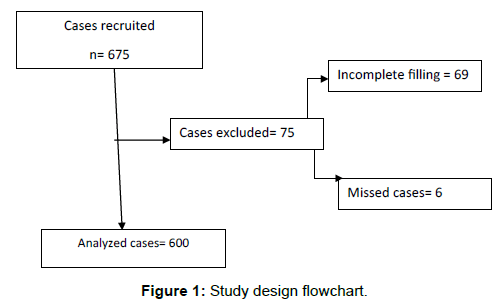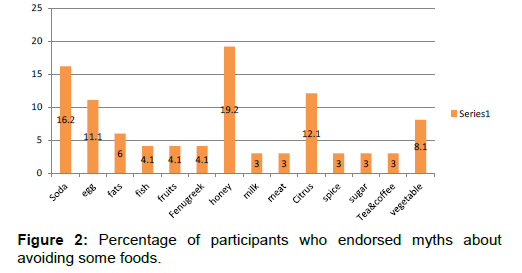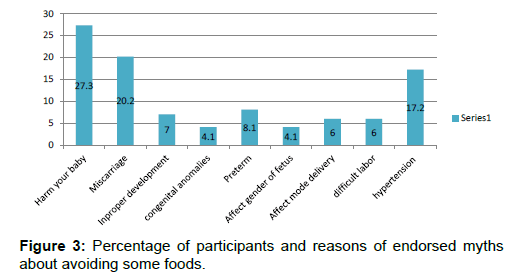Superstitious Food Beliefs and Traditional Customs among Ladies Attending the Antenatal Clinic at Omdurman Maternity Hospital (OMH), Omdurman, Sudan
2 Department of Obstetrics and Gynaecology, College of medicine, Qassim University, Buraidah, Saudi Arabia, Email: m_sammani@yahoo.com
Citation: kheiri SA, Kunna A, Mustafa LS, Shaaeldin MA, Alsammani MA. Superstitious Food Beliefs and Traditional Customs among Ladies Attending the Antenatal Clinic at Omdurman Maternity Hospital (OMH), Omdurman, Sudan. Ann Med Health Sci Res. 2017; 7:218-221
This open-access article is distributed under the terms of the Creative Commons Attribution Non-Commercial License (CC BY-NC) (http://creativecommons.org/licenses/by-nc/4.0/), which permits reuse, distribution and reproduction of the article, provided that the original work is properly cited and the reuse is restricted to noncommercial purposes. For commercial reuse, contact reprints@pulsus.com
Abstract
Objective: This study aimed to describe food taboos and thier possible causes of aviodance during pregnancy among pregnant women attending antenatal care at Omdurman Maternity Hospital, Omdurman, Sudan. Methods: The study was conducted at antenatal clinic Omdurman Maternity Hospital (OMH), Omdurman, Sudan from June to December 2015. Data was gathered by using a questionnaire. Multivariate regression analysis was used to assess the association between mothers endorsed avoidance of food and some selected socio-demographic factors. Results: Out of 600 studied cases, approximately 33 % (198) of them had superstitious food beliefs in pregnancy. There was a significant association between women who endorsed avoidance of food and living in rural areas, having lower education, younger, and inadequate antenatal care. Honey, citrus, eggs, were the most common avoided food items. Reasons for food prohibition included harmed the fetus, miscarriage, preeclampsia and prolonged labor. Conclusion: We found more than one-third of pregnant populating had a superstitious food beliefs. A superstitious food belief is associated with living in rural areas, low level of education and inadequate antenatal care. Diet during pregnancy is influenced by a variety of factors including cultural norms as well as superstitious food beliefs and misconception.
Keywords
Food taboos; Nutrition; Pregnancy; Food traditions
Introduction
The important of nutrition in pregnancy and its implication on pregnancy outcome and subsequent maternal and fetal health is well established. Maintenance of optimal of preconception maternal nutrition throughout pregnancy promotes optimal fetal growth and development.
Pregnancy demands additional nutritional requirements, and pre-pregnancy counseling on dietary requirement during pregnancy is an essential component of good prenatal care.
A food taboo is a prohibition of certain foods during pregnancy and lactation. Unfortunately, the traditional beliefs or food myths is widely practice. Evident have shown that the majority of women adhere to traditional beliefs in their eating habits during pregnancy and lactation. Wang et al. [1] in a study from China, found that more than 90% of the women have poor food practice during pregnancy. It has been identified that food taboos are commoner among poor communities especially in sub-Saharan Africa [2]. The practice of food restrictions has been linked to fetal and maternal malnutrition [3]. It was found that 7% of families of physically challenged children believed that these disabilities are caused by broken food taboos [4]. Some studies reported an association between maternal socio-demographic factors with adherence to food restrictions.
Food taboos and customs is thought to exist as a result of religious or cultural causes. In sudan food taboos has been in described in Nimule sate, Southern Sudan, women and girls in this part of the country are deprived of protein rich foods due to negative cultural beliefs like bad luck, misfortune and miscarriages. [5] In certain communities in Sudan fatty foods and sweets are not allowed during pregnancy as these precipitate dangerously difficult delivery as a result of feto-pelvic disproportions.[6] In central region food customs and practice has not been studied.
In the present study, we intended to address the prevalence, demographic determinants of dietary practices and reasons behind this practice among Sudanese pregnant women.
Materials and Methods
Across s-sectional study was conducted on pregnant ladies attending the antenatal clinic at Omdurman Maternity Hospital (OMH), Omdurman, Sudan from June 1, to December 31, 2015. All pregnant women attending were approached to participate in the study. There were no inclusion or exclusion criteria. Data was gathered by using a questionnaire in the closed way. The basic data that were gathered were; age, parity, occupation, residence, level of education, and usage of antenatal care and dietary restrictions in pregnancy. The women were asked if they had food restriction. If the answer was yes then they were asked for reasons for food-taboo related practices in open questions.
The data was gathered by senior registers, and verbal consent was taken from each participant after explanation of the objectives of the questionnaire.
The sample size of 600 women was determined using the previous prevalence (40.0%) of pica among pregnant Sudanese women that would have 80% power to detect the difference of 3% at α=0.03 [5]. A ten percent of women were expected to have an incomplete data or not responded.
Total of 675 patients were included in the study. Only 600 participants were recruited. The rest of cases were eliminated from the study due to incomplete filling of the questionnaire or missed cases [Figure 1].
The study was approved by Sudan Medical Specialization Board and Omdurman Maternity Hospital ethics committees.
The Statistical Package for the Social Sciences for Windows, version 19.0 (SPSS Inc., Chicago, Illinois) was used for data analysis. The descriptive analyses used included the numbers and associated percentages. Then logistic regression for both univariate and multivariate analysis was performed foods-taboos related practice is the dependent variable and age, occupation, residence, education, and antenatal care were the independent variables. Adjusted odds ratios (OR) and the corresponding 95% confidence interval (CI) were estimated. A p-value <0.05 was considered significant.
Results
There were 600 correct responses out of 675 recruited cases, giving a correct response rate of 788.9%. Of them, 33% (n=198) admitted avoiding certain foods in the current pregnancy while the remaining 67% (402) did not admitted avoiding food during pregnancy.
Most of the participants (62%) were within 25 to 34 years of age and were living in urban areas (86%) and housewives (66.7%). Less than 1.3% of the participants were illiterate, and 62.7% went to college and above. Most of the participants (68%) were multiparous, and only 9.3% were of high parity (>5 deliveries). The majority of the attendants (94.7%) had antenatal care, of them only 12% reported in the first trimester while most of them reported in the third trimester (68.7%). Only 14% of the participants’ were from the Western part of Sudan, 21.3% from the east. 26.7% from the north and 38% from the central area of Sudan [Table 1].
| Level | Frequency | Percentage | |
|---|---|---|---|
| Age group (years) | 15-24 yrs 25-34 yrs 35-45 yrs |
56 186 58 |
18.7 62 19.3 |
| Residence | Urban | 258 | 86 |
| Level of education | Illiterate Primary Secondary Graduate Postgraduate |
4 26 82 164 24 |
1.3 8.7 27.3 54.7 8 |
| Occupation | Housewife Employer Other |
200 70 30 |
66.7 23.3 10 |
| Parity | Primigravidae Multigravida Grandmultipara |
68 204 28 |
22.7 68 9.3 |
| Antenatal care | Yes No 1st trimester 2nd trimester 3rd trimester |
284 16 36 58 206 |
94.7 5.3 12 19.3 68.7 |
| Region | West East North middle |
42 64 80 42 |
14.0 21.3 26.7 38 |
Table 1: Basic demographic factors of participants
Figure 2 lists the percentage of participants who endorsed myths about avoiding some foods. The food items that scored the highest proportion of avoidance included honey, soda, citrus and vegetables, 19.2%, 16.2%, 12.1% and 8.1% respectively.
Figure 3 shows reasons of avoidance of some food items during pregnancy, many of the interviewees (27.3%) thought the eating honey as one of the foods items causes harm to the growing baby and difficult labor while eating eggs pregnant will cause pre-eclampsia/ eclampsia. Other items of food avoided such soda, tea, and coffee, milk, fruits, meat, and sugars.
In logistic regression, younger women were approximately 8 times likely to practice food restriction in pregnancy compared to older ones (OR=7.8, 95% CI= 2.8-21.6, P<0.001), likewise those living in rural areas (OR=8.6, 95% CI=2.762-26.271, P<0.001), with low level of education (OR=1.955, 95% CI=1.216-3.141,P=0.006) and poor antenatal care attendance (OR=6.659, 95% CI=1.915-23.154, P=0.003). On the hand, dietary malpractice was not influenced by ethnicity, occupation and trimester of antenatal care initiation as shown in Table 2.
| Variables | Univariates | Multivariates | ||||
|---|---|---|---|---|---|---|
| OR | 95% CI | P value | OR | 95% CI | P-value | |
| Age | 0.352 | 0.228-545 | 0.000 | 7.766 | 2.797-21.566 | 0.000 |
| Residence | 3.077 | 1.580-5.991 | .001 0 | 8.519 | 2.762-26.271 | 0.000 |
| Ethnic | 0.874 | 0.699-1.091 | 0.234 | 1.088 | 0.824-1.435 | 0.552 |
| Education | 1.034 | 0.769-1.391 | 0.824 0 | 1.955 | 1.216-3.141 | 0.006 |
| Occupation | 1.133 | 0.796-1.612 | 0.488 0 | 0.660 | 0.394-1.106 | 0.115 |
| Parity | 0.482 | 0.306-0.760 | 0.002 0 | 0.3860 | 1.746-8.533 | 001 |
| Antenatal Care | 2.021 | 0.424-0.829 | 0.172 0 | 6.659 | 1.915-23.154 | 0.003 |
| Trimester | 1.939 | 0.424-0.829 | 0.002 0 | 0.836 | 0.520-1.345 | 0.461 |
OR, Odds Ratio; CI Confident Interval, P-value <0.05 is considered significant
Table 2: Factors associated with avoidance of some types of food items, using univariates and multivariates analyses.
Discussion
In this study, approximately, one-third (33%) of the respondents admitted avoiding one food or the other in pregnancy, the foods that commonly avoided in pregnancy were honey, eggs, soda and, vegetables. Main reasons given for avoiding dietary items included harmful to the baby, miscarriage, preterm labor, and hypertension. Socio-demographic factors significantly associated with avoidance of foods in pregnancy included younger age, less education, living in rural areas and inadequate antenatal care.
The recorded prevalence of superstitious food beliefs varies widely between nations. In a study, in rural parts of China, which involved a total of 1,813 women, authors reported that more than 90% of women adhered to the traditional customs [2]. The later authors found that there is a drastic change in eating, sanitation, dress, and daily activity in pregnancy. A comparatively lower prevalence rate (53.3%) was reported by other researchers [6].
The current study revealed that the foods most commonly avoided in pregnancy were honey, eggs, and soda beside many other items. Types of foods that are avoided during pregnancy differ from one country to another. In this study, foods containing sugar like honey, fruits were thought to make the baby large and lead to prolonged labor and caesarean delivery, while eating eggs and meat will cause pre-eclampsia and eclampsia. Other researchers from Africa reported most of the food items revealed by our study, but they differ in the cause of avoidance.
Ekwochi et al. [6]. indicated that proteins are prohibited because of big babies and difficult labor while the egg was commonly avoided because it harms the child.
Traditional food customs and habits are reported more commonly from developing countries, where maternal undernutrition is a major factor for poor pregnancy outcomes. Epidemiology studies from developing countries highlight that imbalance diets negatively affect fetoplacental growth and long-term consequences on offspring [7,8]. This combined effect of under-nourishment and negative food practice added more impact on maternal health in these countries. The adverse fetal outcome as a result of poor maternal nutrition is the leading causes of neonatal death excluding congenital anomalies in developing countries [9]. Introducing proper nutritional programs and adequate antenatal care will save lives of many mothers and children in developing countries. In a multicenter randomized controlled trial (RCT) evaluating maternal outcomes after diet and lifestyle interventions, authors concluded that food and lifestyle intervention reduces the incidence rate of diseases and improving the general health of mothers [10,11]. Furthermore, it has been found that when pregnant women attending antenatal clinics receive nutritional counseling, this will influence their dietary practices [12].
Our study revealed that there was a significant association between women endorsed prohibiting of foods and younger age group, low level of educated, living in rural areas and had had inadequate antenatal care. Similarly, a community-based study conducted in Saki East Local Government of Oyo state, Nigeria, authors found that food taboos significantly associated with were teenage, primigravida, lack of formal education, and lowincome family [13]. Similar results of association were obtained by Zerfu et al. [14]. In many African countries, there is an urbanrural disparity in health services. Failure to deliver essential medical and social services in rural areas may be a significant predictor of many health problems in developing countries including food taboos. [15]
The strengths of this study are its prospective nature and a large number of cases included. The shortcomings of this study are being from a single center rather than multiple centers ,the latter is more representative of the general population and the study did not examined the impact of food taboos on fetal and maternal outcomes.
Conclusion
We found more than one-third of pregnant population had a superstitious food beliefs. Women from the rural areas with a low level of education and with antenatal care utilization were more likely believe in food taboos. Women have different thoughts why food is forbidden indicating that diet during pregnancy is influenced by cultural norms as well as superstitious food beliefs and misconception. Understanding of differences in local, national, and religious food customs between individuals will lead to adequate nutritional education. There is wide room for health care providers to address to the value of balanced food during pregnancy and to eliminate these traditional dietary behaviors.
Conflict of Interest
All authors declare no conflict of interest.
REFERENCES
- Wang XL, Wang Y, Zhou SZ. Puerperal practice pattern in a rural area of north China. Beijing Da Xue Xue Bao. 2007 Apr 18;39:140-144.
- Abubakar A, Holding P, Mwangome M. Maternal perceptions of factors contributing to severe under-nutrition among children in a rural African setting. Rural Remote Health. 2011;11:1423.
- Vasilevski V, Carolan-Olah M. Food taboos and nutrition-related pregnancy concerns among Ethiopian women. J Clin Nurs. 2016 Oct;25:3069-3075.
- Grieger JA, Clifton VL. A review of the impact of dietary intakes in human pregnancy on infant birthweight. Nutrients. 2014 Dec 29;7:153-178.
- Ahmed S, Abdullahi H, Adam I. Practice of pica among pregnant women in Khartoum, Sudan. Int J Gynaecol Obstet. 2012 Jul;118:71-72.
- Meyer-Rochow VB. Food taboos: Their origins and purposes. J Ethnobiol Ethnomed. 2009 Jun 29;5:18.
- Ekwochi U, Osuorah CD, Ndu IK, Ifediora C, Asinobi IN, Eke CB. Food taboos and myths in South Eastern Nigeria: The belief and practice of mothers in the region. J Ethnobiol Ethnomed. 2016 Jan 27;12:17.
- Morrison JL, Regnault TR. Nutrition in Pregnancy: Optimising Maternal Diet and Fetal Adaptations to Altered Nutrient Supply. Nutrients. 2016 Jun 4;8 pII: E342.
- Zerfu TA, Umeta M, Baye K. Dietary habits, food taboos, and perceptions towards weight gain during pregnancy in Arsi, rural central Ethiopia: A qualitative cross-sectional study. J Health Popul Nutr. 2016 Jul 25;35:22.
- Chege PM, Kimiywe JO, Ndungu ZW. Influence of culture on dietary practices of children under five years among Maasai pastoralists in Kajiado, Kenya. Int J Behav Nutr Phys Act. 2015 Oct 8;12:131.
- Bao W, Ma A, Mao L, Lai J, Xiao M, Sun G. Diet and lifestyle interventions in postpartum women in China: Study design and rationale of a multicenter randomized controlled trial. BMC Public Health. 2010 Feb 27;10:103.
- Barger MK. Maternal nutrition and perinatal outcomes. J Midwifery Womens Health. 2010 Nov-Dec;55:502-511.
- Ilmonen J, Isolauri E, Poussa T, Laitinen K. Impact of dietary counselling and probiotic intervention on maternal anthropometric measurements during and after pregnancy: a randomized placebo-controlled trial. Clin Nutr. 2011 Apr;30:156-164.
- Oni OA, Tukur J. Identifying pregnant women who would adhere to food taboos in a rural community: a community-based study. Afr J Reprod Health. 2012 Sep;16:68-76.
- Zerfu TA, Umeta M, Baye K. Dietary habits, food taboos, and perceptions towards weight gain during pregnancy in Arsi, rural central Ethiopia: a qualitative cross-sectional study. J Health Popul Nutr. 2016 Jul 25;35:22.







 The Annals of Medical and Health Sciences Research is a monthly multidisciplinary medical journal.
The Annals of Medical and Health Sciences Research is a monthly multidisciplinary medical journal.